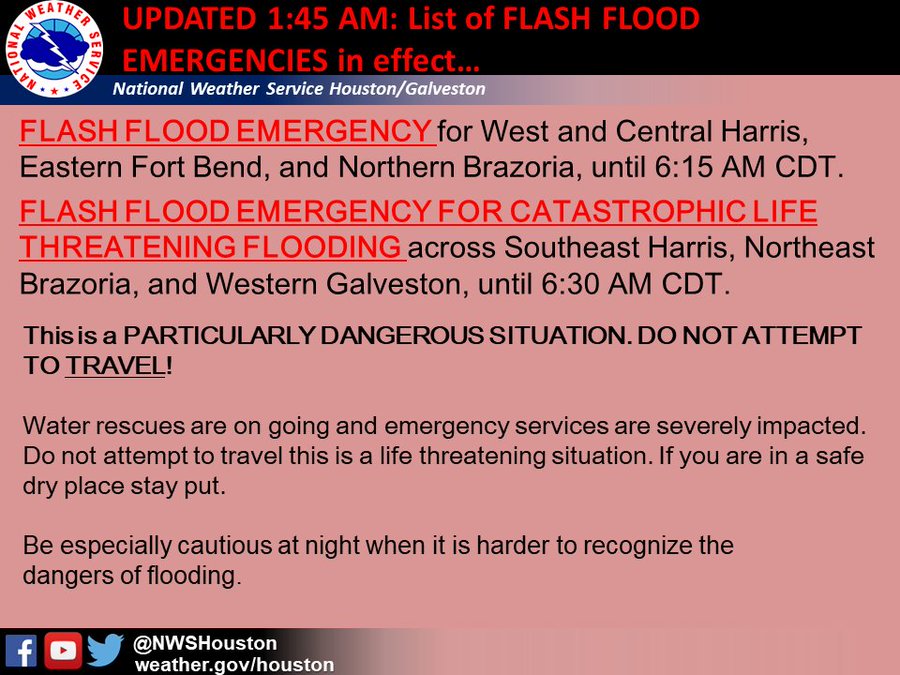Published: April 9, 2020
Flash flood emergencies are a rare alert issued by the National Weather Service that should not only grab your attention, but also serve as a signal that you're likely in imminent danger.
You might have heard of flash flood warnings before. These are issued by the NWS when flash flooding is either already happening or expected to develop soon. According to the Iowa Environmental Mesonet, just over 4,000 of these warnings were issued by the NWS in 2018.
 The distribution of flash flood warnings issued in the U.S. in 2018, parsed by each NWS forecast area.
The distribution of flash flood warnings issued in the U.S. in 2018, parsed by each NWS forecast area.
Most of these incidents brought flooding to perhaps a few low-lying properties.
Typically, at least some streets and roads will be flooded in areas covered by a flash flood warning, which can be dangerous for motorists.
Given the rather large number of flash flood warnings issued, the NWS has begun issuing a more dire alert – called a flash flood emergency – in recent years to highlight rare occasions when there is a major threat to life or potential for catastrophic damage.
When issued, these flash flood emergencies are embedded within existing flash flood warnings as a headline near the top of the warning.
 The difference between a flash flood emergency and flash flood warning.
The difference between a flash flood emergency and flash flood warning.
According to NWS guidelines, situations that may trigger a flash flood emergency include:
-A local or state emergency manager has confirmed rapidly rising water is placing, or will place, people in a life-threatening situation.
-Water is expected, or has already rapidly risen, to levels where people in typically safe locations during other flash flood events will be in danger. These include cases where water could encroach several feet above floor level in a home, requiring rescue and putting the entire home at risk.
-A number of swift-water rescue teams have been deployed to a flash flood of unusual magnitude.
-River and stream gauges indicate water has risen to at least major or rarely seen flood levels.
-Complete failure of a large, high-hazard dam that would have catastrophic impact on downstream areas.
As the graphic above pointed out, if you're in a flash flood emergency, you should not travel unless you're either escaping a flooded area or are ordered to evacuate by local officials.
This is a similar concept to tornado emergencies, which are issued in cases where catastrophic damage and a severe threat to life is imminent or ongoing with a confirmed tornado.
 Water rushes through Main Street in Ellicott City, Maryland, Sunday, May 27, 2018.
Water rushes through Main Street in Ellicott City, Maryland, Sunday, May 27, 2018.Flash Flood Emergency Examples
Recent cases where the NWS issued flash flood emergencies cover a number of damaging and deadly flood events over the past few years.
Over 10 inches of rain in just nine hours triggered a flash flood emergency for Mount Joy, Rapho and Mannheim townships in southeastern Pennsylvania's Lancaster County on Aug. 31, 2018, prompting evacuations.
Three days prior, torrential rain across hilly terrain prompted another flash flood emergency for parts of western Wisconsin, where roads were washed out and evacuations ordered between La Crosse and Wisconsin Dells.
Flash flood emergencies were issued for both the May 2018 and July 2016 destructive flash floods in Ellicott City, Maryland.
The Norman, Oklahoma, NWS office also issued flash flood emergencies for events in early-June 2018 and early-May 2015, among others, due to widespread flooding that swamped roads and threatened homes.
Flash flood emergencies have also been issued to highlight the prolific rainfall flooding with recent hurricanes, like Florence in 2018 in parts of North Carolina, including the Charlotte metro area, and with Harvey's massive rain footprint over the upper Texas coast.
Flash flood emergencies are high-end, violent flash flood events that are causing damage or are likely to be destructive.
If one is issued for your area, take immediate action, similar in some ways to a tornado warning. That quick action could save your life.
The Weather Company’s primary journalistic mission is to report on breaking weather news, the environment and the importance of science to our lives. This story does not necessarily represent the position of our parent company, IBM.
The Weather Company’s primary journalistic mission is to report on breaking weather news, the environment and the importance of science to our lives. This story does not necessarily represent the position of our parent company, IBM.



No comments:
Post a Comment